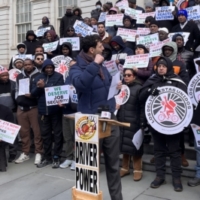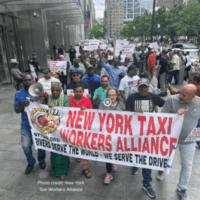Shortages of disposable N95 respirators and other forms of personal protective equipment (PPE) are being widely reported while first responder and healthcare worker illnesses are rising and older nurses and physicians are being called out of retirement to volunteer.
Yet the U.S. Centers for Disease Control and Prevention (CDC) latest guidelines reduce the level of respiratory protection recommended for healthcare workers, while the American Hospital Association opposes Congressional language requiring the Occupational Safety and Health Administration (OSHA) to develop an emergency temporary standard protecting workers.
Healthcare workers are risking their lives and COVID-19 extends that risk to their own families and friends. They also risk transmitting disease to their other patients, often those at high risk.
Diseases are spread in different ways, including by direct contact or droplet spread, airborne spread, surface contamination, and fecal-oral spread. Modelling of disease transmission from a mall in China and exposure experiments reported by the National Institutes of Health indicate that some airborne transmission of this virus is likely.
If SARS Cov-2, the virus that causes COVID-19, is spread by droplet only, a surgical face mask and eye protection would be effective. To protect healthcare workers from airborne exposures, you need at least an N95 respirator, which provides a proper seal so that small particles cannot enter the nose or mouth by racing around the edges of the mask, or better. “Better” means a series of reusable forms of respiratory protection that are available and widely used in healthcare settings. These include elastomeric filtering facepiece respirators as well as powered air purifying respirators (PAPRs) that push filtered air into a loose hood worn by healthcare workers. These respirators have a greater initial cost and require cleaning and training programs for re-use, but are more protective than the disposable N-95 respirators, and are not currently in short supply. Every hospital and nursing home should invest in these re-usable respirators to protect their workers, and hospitals that currently have them in storage should use them.
We have a history of responding late to workers’ needs, driven in part by failure to listen and failure to acknowledge the limitations of our own expertise. In the anthrax mail contamination events following the attacks of 9/11, postal workers who had sorted the contaminated letters died from inhalational anthrax after CDC reassurances that the mail system was safe. And during the 2009 H1N1 influenza pandemic, CDC initially advised against respiratory protection until an Institute of Medicine panel advised it to err on the side of caution. Since that time, many studies have demonstrated airborne transmission of H1N1 and other forms of influenza. Early CDC guidance about Ebola was also not protective enough, and the newly-acquired infections in the US occurred in health care workers.
Much of the current guidance about COVID-19 protection is based on specifics from other coronaviruses such as SARS, MERS, and the common cold, or on the limited case reports published from China. One in five persons infected by SARS was a healthcare worker, and hospitals became sources of outbreaks. Thousands of healthcare workers in China were sickened by COVID-19, and scores died. In Italy and in Spain, hospitals have become focal points for disease spread. Today in the U.S., scores of healthcare workers have already contracted COVID-19.
We don’t know exactly how often or for how long SARS CoV-2 remains airborne or how long it remains infectious on surfaces. We do know that the U.S. Environmental Protection Agency has a long list of disinfectants that will work against it. We know that proper respiratory protection is essential to reducing infection, but proper protection goes beyond personal protective equipment, and needs to include the organization of patient care with an emphasis on ill patient identification, clear triage procedures, the use of engineering controls and contact barriers, and the provision of rest breaks and social supports.
Congress must act now to protect healthcare workers by ensuring an ample supply of N95 masks and gloves reach every hospital, clinic, and nursing facility in the country. Healthcare institutions also urgently need federal funding now to purchase reusable elastomeric filtering facepiece respirators and reusable PAPRS, and to implement training programs, fit testing, and cleaning protocols. This requires a coordinated federal response, not a fragmented and uneven approach that leaves states left on their own to navigate the purchase and dispersal of critical supplies. A decentralized state by state approach is likely to disadvantage healthcare facilities in states with large populations of rural and under resourced citizens.
Congress should legislate a requirement that OSHA protect all workers by issuing an emergency temporary standard to prevent infectious disease transmission to healthcare workers and other essential workers, such as those working in groceries, pharmacies, public safety, emergency response, and other essential sectors that serve the public. OSHA should also be funded to provide technical assistance to hospitals to train and prepare them to implement reusable forms of respiratory protection.
Congress should mandate funding and authorization to enforce strict penalties for hoarding and price gouging of essential medical supplies.
The existential crisis posed by overwhelmed hospitals is obvious. Our lawmakers can and must take steps now to avert this threat.
Melissa J. Perry, ScD, MHS, is a Professor and Chair of the Department of Environmental and Occupational Health at Milken Institute School of Public Health, George Washington University
Rosemary K. Sokas, MD, MOH, is a Professor of Human Science at the Georgetown University School of Nursing and Health Studies and Professor of Family Medicine at the Georgetown School of Medicine
Peter LaPuma, PhD, CIH, is an Associate Professor of Environmental and Occupational Health at Milken Institute School of Public Health, George Washington University



